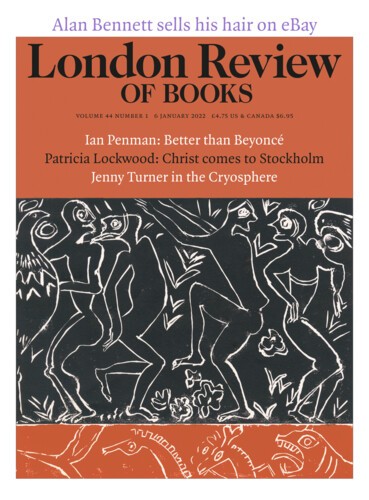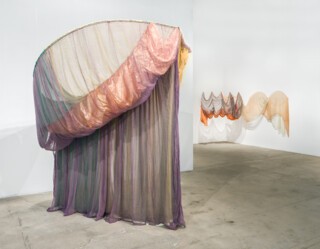Writing in her diary in 1971, the artist Rosemary Mayer, who was then in her late twenties, railed against ‘narrow minded bastards who think objects are only decoration’. Beauty, she wrote, ‘is in the nature of materials as equally as it is in thoughts, process, structures, activities, reactions’. At art school in New York, she produced Minimalist geometric paintings – blocks of colour arranged according to systems of her own devising. Her earliest text-based works were published in the conceptual magazine 0-9, edited by her then husband, Vito Acconci, and her sister, Bernadette. One shows a grid, divided into minutes, into which Mayer scored an ‘X’ each time she heard a firecracker on the night of 4 July 1968. Proposed Street Work involved issuing change-of-address cards for an entire street, so that everyone’s post went to the wrong address – a great flood of neighbours criss-crossing to retrieve their mail. Towards the end of the decade, her work began to take up more space: flat surfaces swelled, shapes and lines spilled off the page. She ripped her canvases from their stretchers and hung them directly onto the wall of her Tribeca loft, staining and splattering them with paint, twisting them into strange new forms.
Mayer’s drawings, which open Ways of Attaching, the survey of her work at the Swiss Institute in New York (until 9 January), provided a testing ground for ‘what materials do … & what I can do to them.’ They show laundry pinned to washing lines, elaborate gowns suggestive of stout ghostly figures, the many-headed protuberances of coloured swatches that she stitched and looped together. She called these ‘impossible’ works and described them as ‘a chance to play with colours & all the possibilities of draping, tying, sewing … without $ … unfettered by space and size’. In 1971, the year she started attending consciousness-raising groups, these drawings expanded into three dimensions. She collected material bought cheap from shops on 14th Street, or given to her by a friend who was a lingerie designer, and dyed and redyed it in her bathtub. Then she folded, layered, stretched it over bent rods and tethered it to walls or ceilings so that it might hold empty space within its bulk. Mayer wrote that these works were ‘between painting and sculpture and taking from both’. Her debut show in 1973 at A.I.R. Gallery, the first all-women co-operative art space in New York (she was a founder), consisted of three ethereal textile pieces titled Hroswitha, The Catherines and Galla Placidia. The formidable Galla Placidia dominates the ground floor at the Swiss Institute, where it is shown alongside two other fabric works, Balancing and Hypsipyle. Its gauzy form – two great swathes of colour (peach, yellow, acid green) open out above a curtain of purple – is distinctly human: a headless dignity with enormous sleeves, an apparition in the process of fading away.
Mayer’s interest in the forms and folds of drapery, the ways in which cloth can be made to gather or billow, led her to Baroque artists – particularly to their paintings of angels – and to the Mannerists Matthias Grünewald and Jacopo da Pontormo, whose diary she translated. (Her painting-collage The Fifth Angel Sleeve, from 1973, riffs on a gesture in Grünewald’s Isenheim Altarpiece.) There is something unsettling about the way her sculptures shift as you walk around them. They move on the air currents, changing colour with the light. Up close, they reveal the labour of their making: neat stitches leave stray ends of fluttering thread; lighter material (net or voile) is often supported by stiffer material (cheesecloth or burlap) inserted carefully behind it, blending colours and textures. It’s tempting to read into these shapes, to see nuptials in the veils, cruelty in the hoops that cleave to the material like corsets, and more so when you consider the phrases Mayer jotted on her drawings or in her notebooks: ‘a cracked egg’; ‘paint dripping thru broken skins’. But she insisted that ‘subject matter is extraneous – it is the materials & their properties that I love.’
Mayer could only construct one piece at a time in her tiny studio, so after a work had been shown and documented it was dismantled, rolled up and stored until its next incarnation. In the late 1970s, her materials became less and less substantial – balloons, ribbons, flowers, snow – and her finished pieces increasingly ephemeral. On occasion the work vanishes altogether. The upstairs gallery is devoted to Mayer’s ‘temporary monuments’: forms of local commemoration she developed in response to events, places or people. For Spell (1977), she visited the farmers’ market in Jamaica, Queens on the day of its spring reopening, setting off decorated balloons and summoning flowers and vegetables from the ground. Some Days in April (1978) paid tribute to her parents, who were both born in April, and to her close friend Ree Morton, who had died in a car crash in April the previous year. She tied balloons to stakes in a field in upstate New York and painted on them the date in April associated with each person, along with the names of flowers in season and constellations visible on that day. Snow People (1979), built outside the library in Lenox, Massachusetts, where Bernadette was living at the time, comprised fifteen figures sculpted from snow, each of them dedicated to women with a particular name (‘Caroline’, ‘Sarah’, ‘Fanny’) who had lived in the town. These fleeting works are represented at the exhibition in the form of photographs, posters or preparatory sketches. In contrast to the macho monuments of the late 1970s and 1980s (Donald Judd et al), Mayer’s commemorations hover somewhere between installation, performance art and party. They recall ancient community festivals (Mayer was a classicist), acknowledging grief and transience, and presenting history as a continuous cycle.
Her work wasn’t always designed to last. Her diaries and letters attest to the difficulties of making unmarketable art without a reliable source of income, and her abiding sense of exclusion from the art establishment. The Swiss Institute show, which will travel to Bristol’s Spike Island Gallery in the autumn, is a significant step towards the recognition she never quite achieved before her death in 2014. Tucked into her diary is a note dated 8 February 1970: ‘Dear Museum of Modern Art, Rosemary Mayer is a real artist. Sol LeWitt.’
Send Letters To:
The Editor
London Review of Books,
28 Little Russell Street
London, WC1A 2HN
letters@lrb.co.uk
Please include name, address, and a telephone number.


